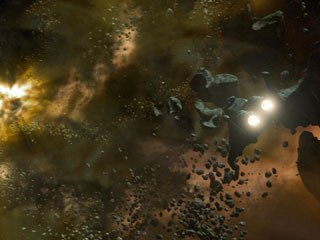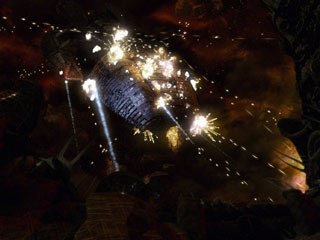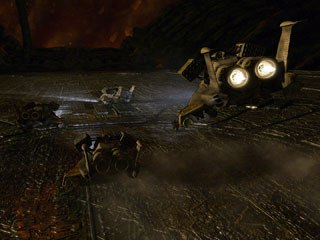Feverishly working round-the-clock as usual to finish the series, Battlestar Galactica's vfx supervisor reviews its achievement along with creator Ron Moore.

The in-house vfx team at Universal television was tasked with making the last three episodes of Battlestar Galactica radically different. All images courtesy of Sci Fi Channel.
After four seasons and 75 episodes, Battlestar Galactica (BSG) signed off last Friday with a rousing, surprising two-hour finale that brings the gripping drama to a close. While many potential viewers were immediately put off by the title alone, audiences willing to give it a try were amply rewarded. The show amassed a dedicated following that was more than willing to stick by this bleak, absorbing sci-fi story that boldly dared to explore such controversial themes as religion, war, and our very existence as human beings more deeply than any other contemporary series on TV.
Battlestar Galactica won a Hugo Award in 2005 and a Peabody in 2006 for its writing, but the show has also been a trailblazer technically especially for its visual effects work. From the beginning, Visual Effects Supervisor Gary Hutzel has led the various incarnations of the vfx team, from their start with Zoic Studios to its current in-house set up with Universal television, and their superior work has been universally recognized by their peers. The team won two Emmy's for Outstanding Special Visual Effects for a Series and this year's VES for Outstanding Visual Effects in a Broadcast Series. With their work on Battlestar, Hutzel and his team raised the bar in creating gritty, documentary-style visual effects that allowed even the most heightened storyline in the series to come across as absolutely authentic and unquestionably real.
In an exclusive chat with VFXWorld, series re-inventor and exec producer Ronald D. Moore says of Hutzel's team, "Their contribution has been enormous. They provided a reality to the world that allowed the audience to suspend their disbelief and accept the dramatic story taking place with our characters. The vfx team convinced the audience that all of these things were really happening, that these Vipers really did fly around and someone had to go shoot them with real cameras. I feel like this was the first time that what happened outside a spaceship was as real as what was happening inside."

Centurions were allowed to emote much more as the series progressed. Gary Hutzel's team was given a very short window of time to finish up the back-end of the final season.
With the finale under their belt (except for a matte bump they were fixing at the last minute), Hutzel joins us again to talk about the end of an era as the Battlestar Galactica chapter closes and his visual effects future continuing the show's mythology in the spin-off series, Caprica.
"As far as the last 10 BSG episodes, the culmination of our work is in the final three hours," Hutzel explains. "The rest of the episodes we really just played more of a supporting role. There wasn't much needed of us. My overall take on the last half of the season was that we had a light schedule of a variety of visual effect sequences where nothing particularly new or demanding was asked for. I think that was Ron looking at [the series] and saying we have a lot of story to cover."
The Sci Fi Channel ordered 22 episodes for the last season and aired the first half in 2008 and then the final 10 episodes in 2009. That year-long spacing translated into a very front-loaded season which was atypical of any season's visual effects work. "In the first half, there was a mish mash of stuff wrapping up storylines from the third season and then they got serious about [tying it up] in the last 10 shows," Hutzel explains. "I think they realized, 'Holy cow we have a lot of ground to cover!' But for us the visual effects were draped on and more a result of thinking we need get outside and give them a break rather than integrated storytelling. And the back 10 were all episodes that languished a long time in editorial. They came to us piecemeal and we did little bits here and there to complete them. There wasn't the usual focus on each individual show. It was more let's get these shots done. Normally we like to focus on individual shows because that's the way Galactica's always been -- it's about the whole picture -- and in the final [post] integrate all of the ideas as much as we can. But we didn't have a lot of that to do in the final 10."

Hutzel and his team raised the bar in creating gritty, documentary-style vfx and received two Emmys and a VES award for it.
"But then the finale was a different thing," he continues with his warm chuckle. "It was interesting because we had a jammed schedule. It turns out with Caprica we did the pilot [in 2008] and we completed it with previs and presented it to the studio and network. But at the time they presented, they didn't feel they had the ability to pick it up so it sat there. Our scheduled delivery date was October [2008] and it sat and sat and sat. Everyone knew it was a winner but they had no scheduled date or game plan for a pick-up. When they did find out about the pick-up, then there was a new game plan from the DVD folks [Universal Home Ent.] that wanted to release Caprica [on April 21]. For that to happen, they need it months in advance so that became a panic because it had to be done immediately. And that pushed the delivery for the BSG finale. So we have been working seven days a week for four months to put these shows out."
But when Hutzel initially got the scripts for the last three episodes, "Islanded in a Stream of Stars" and "Daybreak Part 1 & 2," nothing seemed so dire. "In the beginning, I thought the finale was very light on visual effects," he admits. "In reading it and the way the visual effects played out in the show my concern was that we wouldn't have any set pieces at all but then we had five! It was weird. It was effects light with exterior shots and nothing dramatic but then as it was rebuilt and we got to tell some major story. It was a great opportunity for us. I just wish it happened three months earlier," he sighs with a laugh.
Explaining how it all changed, Hutzel details, "As a whole, for the finale, we wanted to do a lot of new stuff. We didn't want to end on the same note that we had been doing. To that end, we went with a radically new design for the Cylon colony/home world. Michael Rhymer, who directed 'Daybreak Part 1 & 2,' virtually demands that everything be different. His first criterion is will it be different than anything we've done before and then he is down with that. Going into the show it was very demanding for him and tough for him emotionally too. He was literally the heart and soul [of the show] from the beginning and he was there to the last minute. It was like living out a life in four years.

The team worked round-the-clock to get the effects done for the final three episodes, but some extraordinary sequences were achieved.
"So we got into editorial and he was working through the story in his own way and we had lots of dialogue about his issues with the mechanics of the story," Hutzel continues. "He did his edit and we began to work on the study models for the stuff that we discussed. Then it became apparent that they were going to restructure the show, which is standard procedure for the show. I can't remember a show didn't restructure... well there was one," he laughs.
"But they went in and started reforming. By then we had created previs to develop and they were cutting it into the show and as they continued to change it, Ron came in -- and this is months after wrap now -- and said this is not at all what I wanted to do. I think that he was reacting to the new structure of the show and what he felt would be the strongest moment. We had quite an extensive visual effects sequence planned but he didn't want that additional layer to it and wanted it straightforward so we redesigned all that work. The delivery schedule was so short on the show that there was no approval process. We redesigned and had meetings five weeks ago and that was the last meeting we had. There was no time because we just had to do it. But I feel we captured what Ron wanted to do. We haven't discussed that and he might call up and say, 'What the hell did you do?,' because there are a lot of surprises. With the level of detail that we put into the effects and the number of decisions that are made on every effect, it really requires a lot of meetings and in this whole back ten there have been no meetings."

Gary Hutzel.
Going into more specifics about the re-haul, Hutzel adds, "Two weeks ago, Ron added a complete new set piece. It's one of those situations where you can't blame him because he hadn't seen what was going to happen. In the context of the story there was a fairly minor event, nothing to indicate it should be a set piece, so we planned what I thought was an extensive set up to inter-cut with the live action but when Ron saw the previs he said he wanted something powerful and big. We had to build new models around the clock and come up with a new design for the sequence and get it into the show and finaled. I had to comp two of the shots myself because there was no one else who could do them! But we wanted the show to be as big and dramatic as possible, so it's quite a bit over in terms of the visual effects count. Everyone was doing extra time to get the show out and I feel, and I think everyone would agree, it was worth it."
Moore concurs. "I asked a lot of Gary and his team on the final shows, challenged them and pushed them pretty hard, but they were up to the challenge and delivered some extraordinary sequences for the end. I definitely wanted the final actions scenes to be the biggest and most spectacular we'd done and so I wrote on a grand scale in order to let them run wild."
Teasing one of his favorite elements to the finale, Hutzel says, "I think in the finale we took the Centurions full circle. In the miniseries, the request was for the Centurions to play a very small role in the show. They would be anything but humanoid. As we've played out the show, Ron gave me more latitude to show more emotion to the Centurions. In the first couple of seasons, that was verboten -- they must not act! Whereas in the finale all they do is chew up the scenery. For instance, one of the things that occurred is that in the finale we have Centurions on our side and then Centurions on the bad guy side. During pre-production I coined the phrase 'hot Cylon-on-Cylon' action, which ended up in the script, and is basically them fighting amongst themselves. That was never part of the original game plan but for people who enjoy the show they will enjoy that and it's a nice moment."
Looking back on what they've accomplished with Battlestar Galactica, Hutzel admits he's extraordinarily proud of what they were able to contribute in helping make the series something very special. "The first day of shooting we knew we were onto something," he remembers. "I mean that literally. We were on the set for the first day and starting to get the scenes underway and normally on a pilot everyone is trying to find their way. But the very first scenes shot were spectacular -- the drama, the presence of the actors, the level of professionalism -- even Rymer's jaw dropped. It really just worked. You never thought you were shooting a TV show from the beginning to the end. It always felt like the set of a major feature. Through the entire five years, the performances never stopped. It's a kind of lighting that's unlikely to strike again, but I think Caprica has a lot of promise..."
Tara Bennett is an East Coast-based writer whose articles have appeared in publications such as SCI FI Magazine, SFX and Lost Magazine. She is the author of the books 300: The Art of the Film and 24: The Official Companion Guide: Seasons 1-6.








